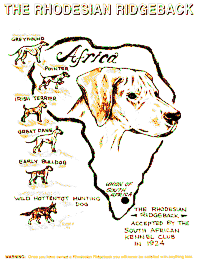 The Rhodesian Ridgeback, sometimes referred to as the African Lion Hound, is a native of South
Africa, having been bred by the Boer farmers to fill their specific need for a serviceable hunting
dog in the wilds.
The Rhodesian Ridgeback, sometimes referred to as the African Lion Hound, is a native of South
Africa, having been bred by the Boer farmers to fill their specific need for a serviceable hunting
dog in the wilds.
The Dutch, Germans, and Huguenots who emigrated to South Africa in the 16th and 17th
centuries brought with them Danes, Mastiffs, Greyhounds, Bloodhounds, Terriers, and other
breeds. For one hundred years, from 1707, European immigration was closed, and the native
dogs played an important part in the development and ultimate character of the Ridgeback.
The Hottentots, a native race living within range of these early settlers, had a hunting dog that
was half wild, with a ridge on his back formed by the hair growing forward. There was inter-breeding between these dogs and those of the settlers, and this crossbreeding, in due course,
established the foundation stock of our present-day Ridgeback.
Good hunting dogs were hard to come by in those days and their value was high. The Boer
settler needed a dog that could flush a few partridge, pull down a wounded buck, and guard the
farm from marauding animals and prowlers at night. He also needed a dog that could withstand
the rigors of the African Bush, hold up under the drastic changes in temperature, from the heat of
the day to nights below freezing, and go a full 24 hours or more without water. He required a
short-haired dog that would not be eaten by ticks. In addition, he needed a companion that would
stay by him while he slept in the bush and that would be devoted to his wife and children. Of
necessity, then, the Boer farmer developed by selective breeding, a distinct breed of the African
Veldt - the Ridgeback.
 In 1877, the Reverend Helm introduced two Ridgebacks into Rhodesia, where the big game
hunters, Selons, Upcher, Van Rooyen, and others found them outstanding in the sport of hunting
lions on horseback. They raised and bred these dogs with an appreciation of their exceptional
hunting qualities; the ridge on their backs becoming a unique trademark. The Standard for the
Ridgeback in South Africa was written in 1922 by a group of Rhodesian Breeders. The
Rhodesian Ridgeback was accepted by the South African Kennel Union (S.A.K.U) in 1924.
In 1877, the Reverend Helm introduced two Ridgebacks into Rhodesia, where the big game
hunters, Selons, Upcher, Van Rooyen, and others found them outstanding in the sport of hunting
lions on horseback. They raised and bred these dogs with an appreciation of their exceptional
hunting qualities; the ridge on their backs becoming a unique trademark. The Standard for the
Ridgeback in South Africa was written in 1922 by a group of Rhodesian Breeders. The
Rhodesian Ridgeback was accepted by the South African Kennel Union (S.A.K.U) in 1924.
Some outstanding specimens were imported to the United States in 1950, and the breed was
admitted to registry by the AKC in 1955.
The Ridgeback, in a comparatively short space of time, has won himself many admirers in the
United States for his innate qualities. He is clean, an easy keeper, and never noisy or
quarrelsome. Because of his heritage, obedience training comes readily to him, and his desire to
please his master, coupled with his general good nature and liking for children, is making him new
friends each year.

 home
home